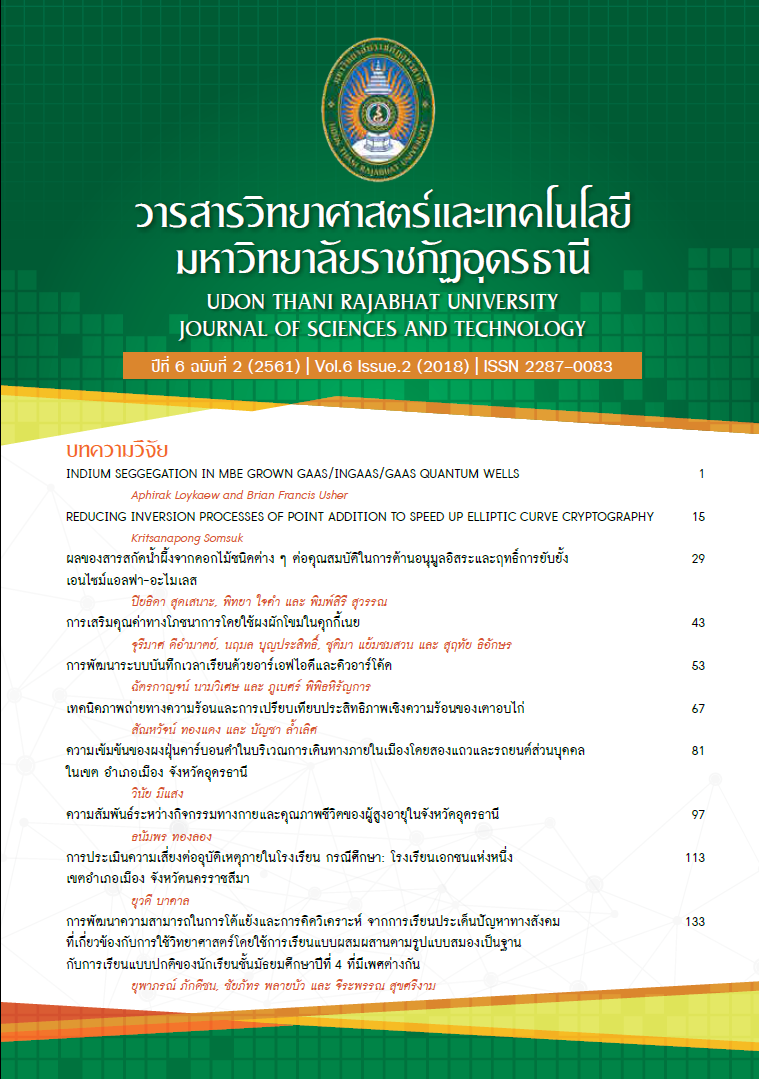INDIUM SEGGEGATION IN MBE GROWN GAAS/INGAAS/GAAS QUANTUM WELLS
Main Article Content
Abstract
Solid state III-V semiconductor device technologies are well established for high speed microwave and optoelectronic devices. Many approaches have been taken to detect indium surface segregation at InGaAs/GaAs interfaces with the purpose of improving interface abruptness. Such studies are not straight-forward and the experimental approaches of many of them misinterpreted indium profiles at the monolayer scale, producing unlikely surface segregation models. The present study employed molecular beam epitaxy (MBE) for layer growth and a novel sample preparation technique was devised which translated vertical chemical depth profiles into horizontal profiles. The use of Time of Flight Secondary Ion Mass Spectrometry (ToF-SIMS) then allowed vertical indium segregation to be observed and measured. Measured indium segregation profiles are found to depend on the primary growth conditions, substrate temperature, the As4 to group III flux ratio and the group III growth rate. A rate equation model was developed that incorporates the primary growth parameters, As4 flux rate, group III growth rate and substrate temperature, to model the growth process kinetically. This fits the experimental data, but only if As4 molecules are assumed to play a site-blocking role that inhibits the chemical incorporation of the group III elements and indium. This model successfully explains the interaction of the group III and V species on gallium and arsenic terminated surfaces in the MBE growth process.
Article Details
References
Foxon, C. T., & Joyce, B. A. (1975). Interaction kinetics of As4 and Ga on {100} GaAs surfaces using a modulated molecular beam technique. Surface Science, 50, 434-450.
Gérard, J. M., d'Anterroches, C., & Marzin, J. Y. (1993). Monolayer scale study of segregation effects in InAs/GaAs heterostructures. Journal of crystal growth, 127(1), 536-540.
Gérard, J. M., & d'Anterroches, C. (1995). Growth of InGaAs/GaAs heterostructures with abrupt interfaces on the monolayer scale. Journal of crystal growth, 150, 467-472.
Loykaew, A., Usher, B. F., Jones, R. T., & Pigram, P. J. (2013). A Novel Sample Structure for the Measurement of Indium Segregation Profiles in GaAs/ InGaAs/GaAs Heterostructures. International Journal of Applied Physics and Mathematics, 3(3), 191-197.
Martini, S., Quivy, A. A., da Silva, M. J., Lamas, T. E., da Silva, E. C. F., Leite, J. R., & Abramof, E. (2003). Ex-situ investigation of indium segregation in In GaAs/GaAs quantum wells using high-resolution x-ray diffraction. Journal of applied physics, 94(11), 7050-7052 .
Mishra, P., Ramesh, V., Srinivasan, T., Singh, S. N., Goyal, A., Sharma, R. K., & Muralidharan, R. (2006). Observation of indium segregation effects in structural and optical properties of pseudomorphic HEMT structures, Semiconductor science and technology, 21(2), 131.
Moison, J. M., Guille, C., Houzay, F., Barthe, F., & Van Rompay, M. (1989). Surface segregation of third-column atoms in group III-V arsenide compounds: Ternary alloys and heterostructures. Physical Review B, 40(9), 6149-6162.
Muraki, K., Fukatsu, S., Shiraki, Y., & Ito, R. (1992). Surface segregation of In atoms during molecular beam epitaxy and its influence on the energy levels in InGaAs/GaAs quantum wells. Applied Physics Letters, 61, 557-559.
Nagle, J., Landesman, J. P., Larive, M., Mottet, C., & Bois, P. (1993). Indium surface segregation in strained GaInAs quantum wells grown on GaAs by MBE. Journal of crystal growth, 127(1), 550-554.
Yamaguchi, K., Okada, T., & Hiwatashi, F. (1997). Analysis of indium surface segregation in molecular beam epitaxy of InGaAs/GaAs quantum wells. Applied surface science, 117, 700-704.
Zheng, J. F., Walker, J. D., Salmeron, M. B., & Weber, E. R. (1994). Interface segregation and clustering in strained-layer InGaAs/GaAs heterostructures studied by cross-sectional scanning tunneling microscopy. Physical review letters, 72(15), 2414-2421.


